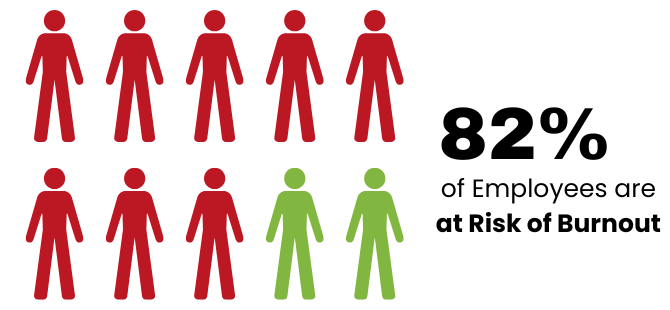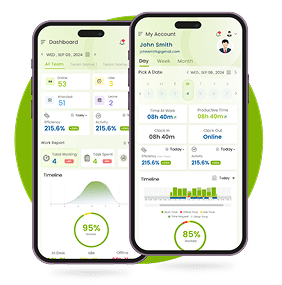Ever feel like your brain has checked out but your body is still clocking in? Welcome to the world of employee burnout. Worker burnout has reached epidemic levels in today’s workforce. In fact, a report from Mental Health UK revealed that one in five UK workers took time off in 2023 due to stress-related mental health issues, while a Vitality study found that Gen Z and young millennials are losing the equivalent of one workday per week due to mental health struggles.
Understanding the causes, symptoms, and potential solutions to employee burnout is key to creating a positive work environment. While each organization faces its own unique challenges, there are effective ways to prevent staff burnout and foster a healthier, more productive workforce such as implementing time tracking software. In this blog, we will break down everything you need to know about employee burnout, including causes, impacts, and strategies and tools to prevent it. Let’s get right into it!
What is Employee Burnout?

Employee burnout is a psychological syndrome that arises as a result of prolonged and chronic stress in the workplace leading to reduced job satisfaction. According to WHO, it occurs when employees feel emotionally drained, mentally exhausted and physically fatigued due to continuous exposure to work-related demands without adequate support or resources.
Burnout is often linked to a perceived lack of control, excessive workloads and insufficient recognition or reward for efforts. It can lead to severe consequences for both employees and organizations, including decreased productivity, high absenteeism in the workplace and a lack of employee engagement.
Burnout vs. General Stress
While burnout and stress may seem similar, they differ in terms of their intensity, duration and impact on an individual’s well-being.
| Feature | General Stress | Burnout |
|---|---|---|
| Cause | Natural response to demanding situations. | Arises from prolonged, unmanaged stress. |
| Duration | Typically short term and tends to resolve once the issue is addressed. | Long term condition and doesn’t dissipate once the immediate cause of stress is removed. |
| Emotional Impact | Can result in anxiety, worry or occasional irritability. | Involves deeper emotional and physical exhaustion. |
| Impact on Performance | Causes a temporary drop in productivity. | Can cause a sustained decline in performance. |
| Response to the Situation | Can be managed through coping strategies like problem-solving, exercise or support. | Requires significant recovery, including taking time off, seeking therapy, etc. |
Major Causes of Employee Burnout
Worker burnout typically results from a combination of factors, including:

Work Overload
Continuous long hours, unrealistic expectations, or excessive responsibilities can lead to burnout. Employees feel they are always on the clock and unable to disconnect from work.

Lack of Control
Employees who feel they have little influence over their work or decision-making processes may experience burnout. When employees feel powerless to change their circumstances it contributes to a sense of helplessness and exhaustion.

Lack of Support
An unsupportive work environment, whether from managers, colleagues, or organizational systems, can exacerbate burnout. Without proper resources, training, and mentorship, employees may feel isolated and stressed.

Unclear Job Expectations
When roles and expectations are not clearly defined, employees may feel confused, stressed, or unsure about how to meet goals or succeed. This uncertainty increases anxiety and can lead to burnout.

Work-Life Imbalance
Constant pressure to perform at work without enough time for personal life, rest, or recovery can quickly lead to burnout. Without a healthy work-life balance, employees' energy reserves are depleted.

Value Mismatch
If an employee's values or interests don't align with the organization or the work they are doing, it can lead to dissatisfaction and burnout. Employees may feel that their work lacks meaning or purpose.

Poor Workplace Relationships
Conflicts among colleagues, or a lack of support from supervisors, can create a toxic work environment. This can make it harder for employees to cope with the challenges of their roles, contributing to burnout.

Unfair Treatment
Perceived injustice and favoritism in the workplace can have a significant negative impact on employee morale. When employees believe that rewards are given based on favoritism, it leads to frustration and resentment.
Symptoms of Employee Burnout
Employee burnout affects various aspects of an individual's well-being, and its symptoms can be classified into three main categories: physical, emotional, and behavioral.
Physical Symptoms
Burnout often manifests in physical ways, which can be a result of chronic stress and prolonged fatigue. These symptoms can be severe and can interfere with an individual’s health and energy levels.
-
Chronic Fatigue: Burnout causes a persistent sense of tiredness that doesn’t improve with rest or sleep.
-
Headaches: Stress and tension from work pressures can result in frequent headaches.
-
Changes in Sleep Patterns: Burnout can disrupt sleep, leading to either insomnia or oversleeping.
-
Gastrointestinal Issues: The stress from burnout can cause digestive problems like stomach aches, nausea, constipation, or diarrhea.
-
Muscle Tension and Pain: Chronic stress from burnout can lead to muscle tension, particularly in the neck, shoulders, and back, causing ongoing pain or discomfort.
Emotional Symptoms
Burnout has a profound emotional impact, leading to feelings of frustration, despair, and detachment. These emotional symptoms can affect an employee’s overall mental health and their interactions with others at work.
-
Feelings of Helplessness: Employees experiencing burnout may feel unable to meet expectations or make a meaningful impact, no matter how hard they try.
-
Cynicism: Burnout often leads to negative, skeptical feelings toward work, colleagues, or the organization, fostering bitterness.
-
Detachment and Apathy: Employees with burnout may emotionally detach from their work, colleagues, and personal goals, leading to disengagement.
-
Mood Swings and Irritability: Burnout can cause significant mood fluctuations, including increased irritability, frustration, or sadness.
-
Anxiety and Depression: Chronic stress and burnout are linked to mental health issues like anxiety and depression, causing constant worry and hopelessness.
Behavioral Symptoms
The behavioral changes associated with burnout can drastically affect an employee's work performance and interactions with others. These behaviors are often signs that an individual is struggling to cope with stress and is becoming increasingly disengaged from their job.
-
Decreased Performance: Burnout leads to a decline in employee performance, with employees struggling to complete tasks on time, resulting in lower-quality work.
-
Withdrawal from Responsibilities: Employees with burnout may withdraw from responsibilities, procrastinate, or disengage due to feeling overwhelmed.
-
Increased Absenteeism: Burnout causes increased absenteeism, with employees taking time off to recover from the physical and emotional toll of their job.
-
Social Withdrawal: Burnout can lead to social withdrawal, as employees may stop participating in team activities or socializing with colleagues.
-
Negative Coping Mechanisms: In an attempt to cope with burnout, employees may turn to unhealthy behaviors like excessive drinking, smoking, or relying on substances like caffeine.
Impact of Burnout on Organizations
Burnout doesn't just affect the individual; it has a significant impact on the entire organization. The ripple effect can lead to decreased productivity, higher costs, and a negative work environment, ultimately affecting the overall success and sustainability of the business.
Reduced Productivity and Efficiency
When employees experience burnout, their performance drops drastically. They struggle to concentrate, meet deadlines and produce high-quality work. As a result, the overall employee efficiency rate decreases, leading to delays, errors and subpar work outputs.
Higher Turnover Rates and Associated Costs
Burnout is a leading cause of employee turnover. As employees reach their breaking point, they may decide to leave the organization in search of a healthier work environment. High turnover rates can be costly for organizations due to the expenses involved in recruiting, hiring and training new employees.
Negative Influence on Workplace Morale and Culture
When employees see their colleagues struggling with burnout or leaving the company due to work-related stress, it creates a sense of unease and disillusionment. This can lead to a decrease in overall job satisfaction and engagement, making employees feel less motivated and committed to their roles.
Strategies to Prevent Employee Burnout
Preventing worker burnout requires a proactive approach that involves creating a supportive work environment, promoting well-being, and providing opportunities for growth and engagement. Here are several key strategies that organizations can implement to prevent burnout and help employees thrive.
Promote Work-Life Balance
Organizations should promote the importance of regular breaks, vacations, and time away from work to help employees recharge. With productivity tracking tools such as Desklog, organizations can set healthy work-hour limits with its break and overtime notification feature ensuring employees don't overwork themselves.
Improve Communication
Fostering an open, transparent communication culture within the workplace is essential in preventing burnout. Employee tracking tools like Desklog can also play a role here by offering managers data on how employees are performing and where they might be struggling.
Provide Recognition and Rewards
Recognizing and rewarding employees for their hard work is an important strategy for preventing burnout. Rewarding employees with bonuses, promotions, or even small gestures of appreciation can help create a positive work environment where employees feel valued and motivated to continue performing at their best.
Ensure Fair Treatment
Organizations should establish transparent policies related to compensation, promotions, and workload distribution to ensure that all employees are treated equitably. It’s important to address grievances promptly and fairly, ensuring that all concerns are taken seriously and resolved in a timely manner.
Implementing Organizational Changes
Implementing organizational changes to address and prevent burnout requires thoughtful planning, ongoing evaluation and a commitment to fostering a supportive work environment. Below are key steps for implementing these changes effectively.

Assess Current Workplace Culture and Identify Stressors
The first step in implementing organizational changes to prevent burnout is to assess the existing workplace culture and identify specific stressors to calculate employee satisfaction rates. Understanding the specific stressors in the workplace is essential to designing targeted interventions that address the underlying issues.
Once the stressors are identified, the organization can prioritize the most pressing issues and take steps to address them, whether through changes in workload distribution, improved communication practices, or implementing support systems such as employee assistance programs (EAPs) or wellness initiatives.

Develop and Enforce Policies that Prioritize Employee Well-Being
After identifying stressors, organizations should create policies that specifically prioritize employee well-being and work-life balance. These policies can include flexible work schedules, mental health support programs, clear guidelines on expected work hours to avoid overtime abuse, and vacation policies that encourage time off.
It’s also essential to create clear boundaries around work expectations—such as discouraging after-hours emails and calls or promoting a culture of respect for personal time. By formalizing these policies and ensuring they are communicated effectively to employees, organizations can create a more supportive environment.

Regularly Evaluate the Effectiveness of Implemented Strategies and Make Adjustments as Needed
Once policies and initiatives are in place, it is critical to regularly evaluate their effectiveness to ensure they are achieving the desired outcomes. This can be done through follow-up surveys, employee feedback sessions, or performance metrics that track the levels of employee engagement, absenteeism, and productivity over time.
By utilizing tools like Desklog, organizations can continuously track employee performance and well-being, helping to evaluate the effectiveness of burnout prevention strategies in real-time and make adjustments as needed to keep employees supported and engaged.
Conclusion
Employee burnout is a serious issue that can have lasting effects on both individuals and organizations. The causes are many, ranging from excessive workloads to lack of support and recognition, but the good news is that it’s preventable. By recognizing the symptoms like chronic fatigue, irritability, and disengagement early, employers can take steps to create a healthier work environment.
Whether it’s promoting work-life balance, offering recognition, or providing leadership support, there are actionable strategies to reduce burnout. Every organization is different, but with the right approach, we can work together to ensure employees are not only productive but also healthy, motivated, and engaged. Remember, a well-rested, supported team is a happy, high-performing team. Let’s make burnout a thing of the past!
FAQ
1What is employee burnout?
Employee burnout is a condition of physical, mental, and emotional exhaustion caused by prolonged or excessive stress at work. It often leads to feelings of detachment, cynicism, and a decline in job satisfaction. Staff burnout can significantly impact both personal well-being and work performance.
2What are the stages of employee burnout?
Employee burnout progresses in five stages:
-
Honeymoon Phase: Full of energy and optimism about the job.
-
Onset of Stress Phase: Stress begins to appear, often unnoticed.
-
Chronic Stress Phase: Persistent stress that starts to affect daily tasks.
-
Burnout Phase: Physical and emotional exhaustion becomes severe.
-
Habitual Burnout Phase: Continuous burnout that is now ingrained in the employee's work life.
3How can I prevent worker burnout?
Preventing employee burnout starts with promoting self-care, ensuring a work-life balance, and managing stress effectively. Encouraging regular breaks, offering support resources, and fostering a positive work environment are key steps in preventing burnout in workers.
4What are the symptoms of staff burnout?
Symptoms of staff burnout include forgetfulness, difficulty concentrating, and an inability to complete tasks. Physical symptoms such as chest pain, headaches, or gastrointestinal issues may also arise. Emotional exhaustion and feelings of detachment from work are common indicators of burnout.
5How long can employee burnout last?
The duration of worker burnout varies. Recovery can take anywhere from several weeks to months or even years, depending on the severity and duration of the burnout. The longer the burnout has been present, the longer it may take to recover.
6How do I identify employee burnout in my team?
To identify employee burnout, look for signs of emotional, mental, and physical exhaustion. Employees may feel drained, disengaged, or isolated. Increased absenteeism, lower productivity, and heightened sensitivity to feedback are also indicators of staff burnout.
7Is burnout the same as a mental breakdown?
No, employee burnout is not the same as a mental breakdown. While both involve extreme emotional distress, burnout is specifically related to work-related stress, whereas a mental breakdown can encompass a broader range of emotional crises.
8What happens if employee burnout is ignored?
Ignoring employee burnout can lead to severe mental health issues such as depression or anxiety. If left unaddressed, burnout can worsen, reducing motivation, productivity, and overall well-being. It’s crucial to recognize and address burnout before it becomes overwhelming and detrimental to the worker's health.

















